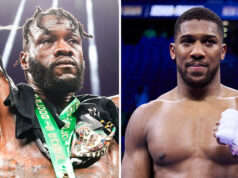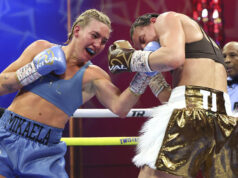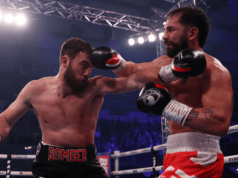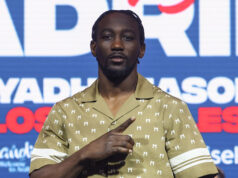Taking A Look at the Future of Amir Khan
It is no secret that Amir Khan has a questionable chin. How far can he go with such an Achilles heel? What are the historical precedents concerning fighters with this weakness? Can you make it to the top of the sport with a weak chin?
It is perhaps the most visible of all boxer shortcomings. Fighters often have a weakness yet still manage to forge their way to the top. You will often see top fighters with deficiencies in power, speed, defense, punch variety, and a bevy of other inadequacies, but how many top fighters have you seen with a weak chin? How many great fighters have there been who are one clean clout away from dilapidation at any given moment?
The answer is you do not see it very often. A weak chin will seldom allow a fighter to zoom seamlessly to the top and stay there for very long. Sometimes the chin is exposed during the prospect stage, the contender stage, or perhaps even later after garnering world title honors. Whatever the case, it invariably will be exposed.
Let’s look at other successful weak-chinned fighters and see if we can’t find a precedent that is favorable to Amir Khan:
Terry Norris
Perhaps the most analogous of all chinny fighters to Amir Khan. Norris was a prodigiously gifted boxer blessed with copious amounts of speed and power. Norris’ chin seemed less of an issue when he used movement, but when he elected to trade in the trenches, the result was usually a stoppage defeat. Khan could stand to learn some valuable lessons about career management by studying the course of “Terrible” Terry.
Norris was on the precipice of greatness several times during his career. His weak chin, however, would never quite allow his greatness to take a firm hold. Norris would build up momentum, only to see his weak chin betray him time and again, sending him to the back of the pack to regroup.
Norris’ chin was hardly granite, but his questionable ring I.Q. hastened his demise. Standing still against the ropes against murderous-punching Julian Jackson and cooperatively swinging your head directly into the wheelhouse of Simon Brown are surefire ways to get your block knocked off, especially with a dubious set of whiskers. Terry sure didn’t make it easy on himself.
Wladimir Klitschko
His recent utter dominance should attract Khan’s attention. Whether Wlad really has a weak chin is more questionable, as two of his stoppage defeats appeared to result more from fatigue than chin fragility. Nevertheless, his chin was and continues to be a point of concern.
How has he managed to revive his career? Did his chin become better? That seems unlikely. His resurrection is more based on tactical than anatomical improvements. He has mastered the art of non-engagement, realizing that a “fight” is not in his best interest. The times where he has been in a hotly contested scrap, he has come up short or struggled mightily. His goal is to use his mastery of ring geometry and geography to subdue his opponents. He uses his reach and his legs. The last thing he wants is an actual fight.
While it may alienate some fans that he takes the safety-first mindset too far at times, the discipline he employs in showcasing his talents while concealing his weaknesses should be a point of inspiration for Khan.
Roy Jones
Perhaps he best laid out the blueprint for Khan to follow. He was always a step ahead of his opponents during his long prime so his chin was never significantly tested. Maybe it was glassy all along or it could have merely deteriorated over time. The answer probably lies somewhere in the middle.
What isn’t in debate, however, is that Jones used his gifts to avoid being put in precarious situations and Khan should do the same even if it strikes against his natural fighting urges. One element making this more difficult for Khan is that Jones had never been splattered on the canvas like pancake batter until much later. Opponents surely would have been gunning harder for Jones had they known one good shot could make such a cataclysmic impact.
Positive Signs
One cannot ignore Khan’s partnership with Freddie Roach when forecasting his future. Seeing what Roach did with two-time KO victim Manny Pacquiao should send wind into the sails of Khan supporters. Roach is masterful in bringing the best out of his pupils, enabling them to shine while camouflaging their shortcomings. Nowadays, you rarely see Pacquiao in a precarious position in the ring. He has become a master of range.
Some of this has rubbed off on Khan. You see him more comfortable utilizing his skill and forgoing the macho approach that exponentially increases the possibility of a KO defeat.
It may be a disguised blessing that the Prescott loss occurred when it did. Khan can now forge ahead with an established identity—an enormously gifted yet vulnerable fighter who at least knows his limitations. Had a similar result happened in the midst of a world title run, the momentum would have taken longer to regain. He just turned 23 and is already at or near the top of a deep and talented division. It didn’t set him back too far.
Recommended Course of Action
With so many formidable fighters at and around his weight, Khan will have his hands full. His talent will see him through many fights. His work with Freddie Roach will help him maximize his talent. Khan stands to be a fixture in the alphabet title mix for the next decade or more. How much foothold he can gain in the pound-for-pound ratings is dependent on many variables.
Matchmaking will be key. He would be well advised to avoid low-reward bouts with dangerous but uncelebrated punchers. His next opponent was supposed to be Marcos Maidana, who is a more dangerous proposition to Khan than the gulf in their respective skills suggests. Khan’s team should opt for the same matchmaking approach that pitted Tommy Hearns against Virgil Hill, rather than Nigel Benn. It appears they have, as Maidana has been scratched as Khan’s next opponent.
Khan’s management should look to the Ken Norton example. Norton looked great against Ali, but folded like a house of cards to the man Ali beat—George Foreman. He gave Holmes fits, yet caved in quickly to two Holmes victims—Earnie Shavers and Gerry Cooney. Khan should only fight a huge puncher if the possible reward warrants such a risk, for example, when Hearns fought Hagler or when Norton fought Foreman.
Khan’s Future
Some version of the Terry Norris career trajectory seems likely for Khan. He will flash greatness, score a great win or two, but have his ascension interrupted by a few slip-ups. Exactly whom he fights and how disciplined Khan can be will figure enormously into his career, but history indicates he will very likely have his share of bad moments. One must look far down the all-time greats list before finding a fighter with substantial liabilities in the durability category. It cannot be hidden forever.










